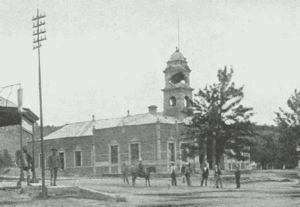Siege of Ladysmith
| Siege of Ladysmith | |||||||
|---|---|---|---|---|---|---|---|
| Part of Second Boer War | |||||||
 The town hall at Ladysmith, showing shell damage to the tower |
|||||||
|
|||||||
| Belligerents | |||||||
|
|
|
||||||
| Commanders and leaders | |||||||
|
|
|
||||||
| Strength | |||||||
| 12,500 | max 21,000 men | ||||||
| Casualties and losses | |||||||
| c. 850 killed and wounded 800 prisoners |
52+ killed Total casualties unknown |
||||||
The Siege of Ladysmith was a protracted engagement in the Second Boer War, taking place between 2 November 1899 and 28 February 1900 at Ladysmith, Natal.
As war with the Boer republics appeared likely in June 1899, the War Office in Britain dispatched a total of 15,000 troops to Natal, expecting that if war broke out they would be capable of defending the colony until reinforcements could be mobilized and sent to South Africa by steamship. Some of these troops were diverted while returning to Britain from India, others were sent from garrisons in the Mediterranean and elsewhere. Lieutenant General Sir George White was appointed to command this enlarged force. White was 64 years old and suffered from a leg injury incurred in a riding accident. Having served mainly in India, he had little previous experience of South Africa.
Contrary to the advice of several British officials such as Sir Alfred Milner, the High Commissioner for Southern Africa, the Boer governments were not over-awed by the despatch of British troops to Natal. Instead, they regarded it as evidence of Britain's determination to seize control of the Boer republics. The Transvaal government under President Paul Kruger considered launching an attack in September, but President Steyn of the Orange Free State, who would later become the spiritual heart of the Boer resistance, dissuaded them for several weeks while he tried to act as intermediary. With the complete breakdown in negotiations, both republics declared war and attacked on 12 October.
A total of 21,000 Boers advanced into Natal from all sides. White had been advised to deploy his force far back, well clear of the area of northern Natal known as the "Natal Triangle", a wedge of land lying between the two Boer republics. Instead, White deployed his forces around the garrison town of Ladysmith, with a detachment even further forward at Dundee. The entire British force could concentrate only after fighting two battles at Talana Hill and Elandslaagte. As the Boers surrounded Ladysmith, White ordered a sortie by his entire force to capture the Boer artillery. The result was the disastrous Battle of Ladysmith, in which the British were driven back into the town having lost 1,200 men killed, wounded or captured.
...
Wikipedia
